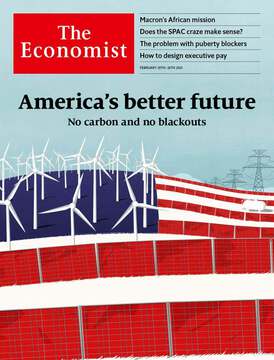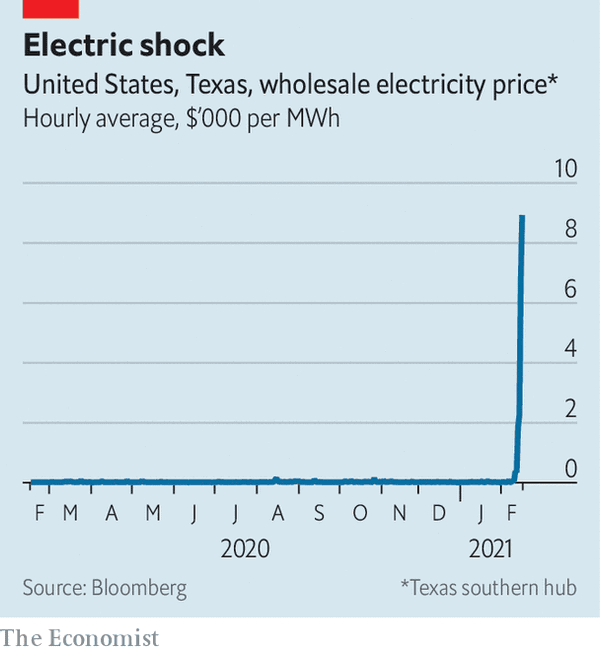
本期经济学人杂志【美国】板块下这篇题为《The freeze in Texas exposes America’s infrastructural failings》的文章关注的是罕见暴风雪天气袭击美国南部,能源首府德克萨斯州经历了 30 年来最严寒天气,约 450 万家庭电力供应中断,一半德州人无法获得安全的饮用水。
最近极端天气席卷美国南部,天然气管道运输被迫中断,部分核反应堆停止工作。作为美国能源首府的德克萨斯州却没有可靠的电力供应,2 月 16 日该州有 450 万户家庭停电。对于本次大面积停电事故,文章认为可能的原因有:
- 一、运营德州电网的电气可靠性委员会未能准确预测发生极端天气时的电力需求。
- 二、在美国本土 48 个州中,只有德州完全只依靠自己的电厂而不从其他州进口电力。所以当电力系统被破坏时,德州无法从其他州获得电力帮助。
- 三、德州大约有 300 家电力零售商,电力零售市场竞争激烈,但它们并没有针对极端寒冷天气进行投资,因为这会增加它们的成本并提高电价。
德州每度电的价格为 8.6 美分,只有加州的一半,比全美平均电价便宜 20%。德州在 1999 年就开始设立清洁能源目标,目前德州的风电占全美的 30%。大面积停电后有共和党议员批评清洁能源发电,但文章认为这不太公平,因为德州 50% 的电力来自天然气发电,天然气管道冰堵才是停电的主要原因。
文章最后认为,以前认为不太出现的极端天气现在似乎变得越来越寻常,如果不对电网进行更多投资,那类似的停电事故还会再发生。

The freeze in Texas exposes America's infrastructural failings
Light a candle for the kids
The freeze in Texas exposes America’s infrastructural failings
You ain’t foolin’ nobody with the lights out
United States
Feb 20th 2021 edition
Feb 17th 2021
WHEN IT RAINS, it pours, and when it snows, the lights turn off. Or so it goes in Texas. After a winter storm pummelled the Lone Star State with record snowfall and the lowest temperatures in more than 30 years, millions were left without electricity and heat. At the worst moment on February 16th, 4.5m Texan households were cut off from power, as providers were overloaded with demand and tried to shuffle access to electricity so the entire grid did not collapse.
Whole skylines, including Dallas’s, went dark to conserve power. Some Texans braved the snowy roads to check into the few hotels with remaining rooms, only for the hotels’ power to go off as they arrived. Others donned skiwear and remained inside, hoping the lights and heat would come back on. Across the state, what were supposed to be “rolling” blackouts lasted for days. It is still too soon to quantify the devastation. More than 20 people have died in motor accidents, from fires lit for warmth and from carbon-monoxide poisoning after using cars to get warm. The storm has also halted deliveries of covid-19 vaccines and may prevent around 1m vaccinations from happening this week. Several retail electricity providers are likely to go bankrupt, after being hit with surging wholesale power prices.
Other states, including Tennessee, were also covered in snow, but Texas got the lion’s share and ground to a halt. Texans are rightly furious that residents of America’s energy capital cannot count on reliable power. Everyone is asking why.
The short answer is that the Electric Reliability Council of Texas (ERCOT), which operates the grid, did not properly forecast the demand for energy as a result of the storm. Some say that this was nearly impossible to predict, but there were warnings of the severity of the coming weather in the preceding week, and ERCOT’s projections were notably short. Brownouts last summer had already demonstrated the grid’s lack of excess capacity, says George O’Leary of Tudor, Pickering, Holt & Co (TPH), an energy investment bank.
Many Republican politicians were quick to blame renewable energy sources, such as wind power, for the blackouts, but that is not fair. Some wind turbines did indeed freeze, but natural gas, which accounts for around half of the state’s electricity generation, was the primary reason for the shortfall. Plants broke down, as did the gas supply chain and pipelines. The cold also caused a reactor at one of the state’s two nuclear plants to go offline. Transmission lines may have also iced up, says Wade Schauer of Wood Mackenzie, a research firm. In short, Texas experienced a perfect storm of equipment failure.
Some of the blame falls on the unique design of the electricity market in Texas. Of America’s 48 contiguous states, it is the only one with its own stand-alone electricity grid—the Texas Interconnection. This means that when power generators fail, the state cannot import electricity from outside its borders.
The state’s deregulated power market is also fiercely competitive. ERCOT oversees the grid, while power generators produce electricity for the wholesale market. Some 300 retail electricity providers buy that fuel and then compete for consumers. Because such cold weather is rare, energy companies do not invest in “winterising” their equipment, as this would raise their prices for consumers. Perhaps most important, the state does not have a “capacity market” to ensure that there was extra power available for surging demand. Such systems elsewhere act as a sort of insurance policy so the lights will not go out, but it also means customers pay higher bills.
For years the benefits of Texas’s deregulated market structure were clear. At 8.6 cents per kilowatt hour, the state’s average retail price for electricity is around one-fifth lower than the national average and about half the cost of California’s. In 1999 the state set targets for renewables, and today it accounts for around 30% of America’s wind energy.
This disaster is prompting people to question whether Texas’s system is as resilient and well-designed as people previously believed. Greg Abbott, the governor, has called for an investigation into ERCOT. This storm “has exposed some serious weaknesses in our free-market approach in Texas”, says Luke Metzger of Environment Texas, a non-profit, who had been without power for three full days when The Economist went to press.
Wholly redesigning the power grid in Texas seems unlikely. After the snow melts, the state will need to tackle two more straightforward questions. The first is whether it needs to increase reserve capacity. “If we impose a capacity market here and a bunch of new cap-ex is required to winterise equipment, who bears that cost? Ultimately it’s the customer,” says Bobby Tudor, chairman of TPH. The second is how Texas can ensure the reliability of equipment in extreme weather conditions. After a polar vortex in 2014 hit the east coast, PJM, a regional transmission organisation, started making higher payments based on reliability of service, says Michael Weinstein of Credit Suisse, a bank. In Texas there is no penalty for systems going down, except for public complaints and politicians’ finger-pointing.
Texas is hardly the only state to struggle with blackouts. Parts of California, which has a more tightly regulated power market, are regularly plunged into darkness during periods of high heat, winds and wildfires. Unlike Texas, much of northern California is dependent on a single utility, PG&E. The company has been repeatedly sued for dismal, dangerous management. But, as in Texas, critics have blamed intermittent renewable power for blackouts. In truth, California’s blackouts share many of the same causes as those in Texas: extreme weather, power generators that fail unexpectedly, poor planning by state regulators and an inability (in California, temporary) to import power from elsewhere. In California’s blackouts last year, solar output naturally declined in the evening. But gas plants also went offline and weak rainfall lowered the output of hydroelectric dams.
In California, as in Texas, it would help to have additional power generation, energy storage to meet peak demand and more resilient infrastructure, such as buried power lines and more long-distance, high-voltage transmission. Weather events that once might have been dismissed as unusual are becoming more common. Without more investment in electricity grids, blackouts will be, too. ■
For more coverage of climate change, register for The Climate Issue, our fortnightly newsletter, or visit our climate-change hub
This article appeared in the United States section of the print edition under the headline"Light a candle for the kids"
